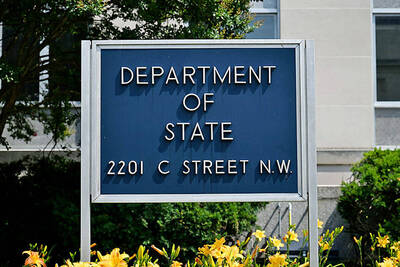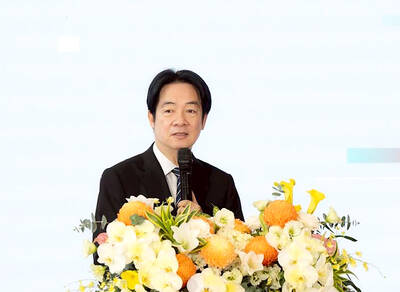The Cabinet yesterday approved a tax reform proposal that would cut the maximum estate and gift taxes from 50 percent to 10 percent in a move that critics say would cause taxation and socioeconomic inequality.
Also included in the proposal were plans to increase standard and special tax deductions for salaries, tuition fees and households with disabled family members. The inclusion of the exemptions came earlier than expected and was seen as a bid to counter criticism that the tax plan would only benefit the rich.
“Many people think that estate and gift taxes are big revenue generators, but in fact estate and gift tax revenues average only around NT$20 billion [US$612 million] to NT$30 billion a year, which is a trivial part of the government’s total tax revenue of NT$1.7 trillion,” Minister of Finance Lee Sush-der (李述德) said.
Lee said the measure with the greatest influence on taxation fairness was the tax exemption expansion scheme, which would benefit 3.6 million households.
“Raising the tax exemption limits in the four items will decrease the tax liability of a dual-income family of four with two college students, for example, by between NT$5,820 and NT$38,800, depending on the marginal income tax,” Lee said.
Lee made the remarks at a press conference following the weekly Cabinet meeting.
Under the proposals, a flat 10 percent tax rate would be set for both the estate and gift taxes, replacing 10 levels ranging between 2 percent and 50 percent.
The proposal also raises the estate tax exemption from NT$7.79 million to NT$12 million and the gift tax exemption from NT$1.11 million to NT$2.2 million.
“Lowering the rates will attract more capital into the country because wealthy people won’t bother depositing money abroad to avoid paying taxes if the cost of tax evasion is equivalent to their estate tax and gift tax,” Lee said.
Estimates have shown that high tax rates did not generate more tax revenue, Lee said, adding that only 4,684 of the 88,170 people with potential estate tax liabilities and only 27,597 of the 188,704 people with potential gift tax liabilities paid the tax last year.
“Moreover, most of the 4,684 payers of estate tax were from the middle class rather than wealthy individuals, as only about 100 individuals had more than NT$100 million in tax liabilities,” Lee said.
Under the exemption expansion scheme, the Cabinet raised the standard deduction for a single taxpayer from NT$46,000 to NT$60,000 and that for a married taxpayer from NT$92,000 to NT$120,000.
The government suggested increasing the special deductions threshold for salaries from NT$78,000 to NT$100,000, and for households with disabled family members from NT$77,000 to NT$100,000.
Meanwhile, the Cabinet said it would allow taxpayers to claim a special deduction of NT$25,000 for each child attending college, while currently only NT$25,000 per household is allowed, regardless of how many children are enrolled in higher education.
Lee said the government expected the estate and gift tax reduction proposal to cause tax revenues losses of about NT$20 billion and the exemption changes to cause a loss of NT$1.54 billion.
Also See: Cabinet approves setting gift tax at 10%

MISINFORMATION: The generated content tends to adopt China’s official stance, such as ‘Taiwan is currently governed by the Chinese central government,’ the NSB said Five China-developed artificial intelligence (AI) language models exhibit cybersecurity risks and content biases, an inspection conducted by the National Security Bureau (NSB) showed. The five AI tools are: DeepSeek, Doubao (豆包), Yiyan (文心一言), Tongyi (通義千問) and Yuanbao (騰訊元寶), the bureau said, advising people to remain vigilant to protect personal data privacy and corporate business secrets. The NSB said it, in accordance with the National Intelligence Services Act (國家情報工作法), has reviewed international cybersecurity reports and intelligence, and coordinated with the Ministry of Justice Investigation Bureau and the National Police Agency’s Criminal Investigation Bureau to conduct an inspection of China-made AI language

LIMITS: While China increases military pressure on Taiwan and expands its use of cognitive warfare, it is unwilling to target tech supply chains, the report said US and Taiwan military officials have warned that the Chinese People’s Liberation Army (PLA) could implement a blockade within “a matter of hours” and need only “minimal conversion time” prior to an attack on Taiwan, a report released on Tuesday by the US Senate’s China Economic and Security Review Commission said. “While there is no indication that China is planning an imminent attack, the United States and its allies and partners can no longer assume that a Taiwan contingency is a distant possibility for which they would have ample time to prepare,” it said. The commission made the comments in its annual

CHECKING BOUNDARIES: China wants to disrupt solidarity among democracies and test their red lines, but it is instead pushing nations to become more united, an expert said The US Department of State on Friday expressed deep concern over a Chinese public security agency’s investigation into Legislator Puma Shen (沈伯洋) for “secession.” “China’s actions threaten free speech and erode norms that have underpinned the cross-strait ‘status quo’ for decades,” a US Department of State spokesperson said. The Chongqing Municipal Public Security Bureau late last month listed Shen as “wanted” and launched an investigation into alleged “secession-related” criminal activities, including his founding of the Kuma Academy, a civil defense organization that prepares people for an invasion by China. The spokesperson said that the US was “deeply concerned” about the bureau investigating Shen

‘TROUBLEMAKER’: Most countries believe that it is China — rather than Taiwan — that is undermining regional peace and stability with its coercive tactics, the president said China should restrain itself and refrain from being a troublemaker that sabotages peace and stability in the Indo-Pacific region, President William Lai (賴清德) said yesterday. Lai made the remarks after China Coast Guard vessels sailed into disputed waters off the Senkaku Islands — known as the Diaoyutai Islands (釣魚台) in Taiwan — following a remark Japanese Prime Minister Sanae Takaichi made regarding Taiwan. Takaichi during a parliamentary session on Nov. 7 said that a “Taiwan contingency” involving a Chinese naval blockade could qualify as a “survival-threatening situation” for Japan, and trigger Tokyo’s deployment of its military for defense. Asked about the escalating tensions